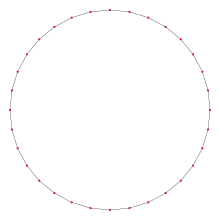Triacontadigon
| Regular triacontadigon | |
|---|---|

A regular triacontadigon
|
|
| Type | Regular polygon |
| Edges and vertices | 32 |
| Schläfli symbol | {32}, t{16}, tt{8}, ttt{4} |
| Coxeter diagram |
|
| Symmetry group | Dihedral (D32), order 2×32 |
| Internal angle (degrees) | 168.75° |
| Dual polygon | Self |
| Properties | Convex, cyclic, equilateral, isogonal, isotoxal |
In geometry, a triacontadigon (or triacontakaidigon) or 32-gon is a thirty-two-sided polygon. In Greek, the prefix triaconta- means 30 and di- means 2. The sum of any triacontadigon's interior angles is 5400 degrees.
An older name is tricontadoagon. Another name is icosidodecagon, suggesting a (20 and 12)-gon, in parallel to the 32-faced icosidodecahedron, which has 20 triangles and 12 pentagons.
The regular triacontadigon can be constructed as a truncated hexadecagon, t{16}, a twice-truncated octagon, tt{8}, and a thrice-truncated square. A truncated triacontadigon, t{32}, is a hexacontatetragon, {64}.
One interior angle in a regular triacontadigon is 168 1⁄4°, meaning that one exterior angle would be 11 1⁄4°.
The area of a regular triacontadigon is (with t = edge length)
and its inradius is
The circumradius of a regular triacontadigon is
As 32 = 25 (a power of two), the regular triacontadigon is a constructible polygon. It can be constructed by an edge-bisection of a regular hexadecagon.
The regular triacontadigon has Dih32dihedral symmetry, order 64, represented by 32 lines of reflection. Dih32 has 5 dihedral subgroups: Dih16, Dih8, Dih4, Dih2 and Dih1 and 6 more cyclic symmetries: Z32, Z16, Z8, Z4, Z2, and Z1, with Zn representing π/n radian rotational symmetry.
...
Wikipedia
